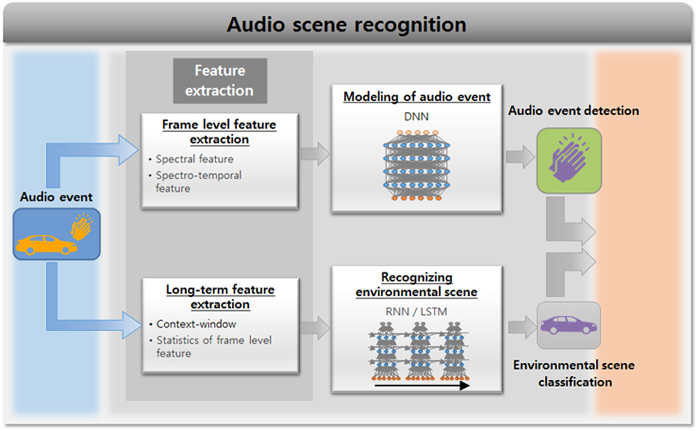Audio signal processing
Realistic audio technology
When a musical instrument is played, the sound radiated from the instrument is affected by various elements before it is perceived by the listener, including the directivity patterns of the musical instrument and the room impulse response of the concert hall. Applications of spatial sound reproduction include 3D realistic audio systems, analysis of acoustic wave path, and so on. This research explains the method for reproducing the spatial sound using a recorded anechoic sound source and a measured room impulse response.
- Spatial sound reproduction system
- Room impulse response, head related transfer functions
- Wave field synthesis, ambisonic
Audio scene recognition
Audio scene recognition aims to the computational analysis of an acoustic environment and the recognition of distinct sound events in it. The focus of audio scene recognition is in recognizing the context or environment, and analyzing discrete sound events.
- Audio event detection
- Environmental scene classification

Audio event detection
Audio event detection systems aim to recognize and distinguish particular acoustic events related to human, nature or machine presence. It describes an acoustic scene in terms of elementary events and related acoustic sources.

Environmental scene classification
Environmental scene classification is the task of identifying in which acoustic environment a sound was recorded using only the audio signal. It has a variety of real life applications such as robotic navigation or forensics.
Acoustic localization
Acoustic localization is an area that studies localization or tracking of acoustic sources or target microphones based on the various measurements of the sound field. It can be applied to various location based services such as the virtual tour guide in museums, tracking of personal items, or the guide in shopping malls.
- Acoustic source localization and tracking
- Indoor localization using acoustic signals

Sound code
-
Sound code is a wireless data transmission system by encoding data using an audio data hiding technology and playing through a loudspeaker.
- Transmitting user-specified information (phone number, email address, URL, or a piece of code) by encoding data
into an audio track without any discernable distortion and playing through a loudspeaker.
- Decoding original message using a smart device (smart phones, tablet PCs, etc.) with an embedded microphone. - It can be applied to inserting product information, distributer information, coupon codes, etc. into advertisements.
-
Characteristics of Sound Codes
- Encoding signals within the audible frequency range
- Allows playback through a generic loudspeaker
- Robust against various audio CODECs
- Audio quality similar to the original


Audio source separation
Audio signal usually consists of the target sound and background noise. Audio source separation is a technique of extracting a single or several signals of interest from a mixture signals. It removes unwanted components from a recording.
- Single channel/source separation
- Multi channel/source separation




